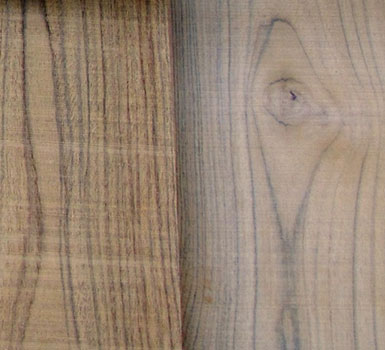What are the best ways to preserve Teak? In our fifth blog we explore Sealers and Finishes
Finishes are very dependent on user preference and on the use of the teak. In many cases, if the use is highly specific, (like marine decking maintenance) it is best to talk to professionals in that industry. However, as a rule plantation teak is easier to finish (and glue) than old growth teak. The concentration of oils is generally less in plantation teak thus making it easier to work with.
Plantation Teak is naturally beautiful if left without finish. However, if exposed to sunlight, teak will weather to a silver colour over about a year. Bare and weathered teak is well protected by its natural oils. If this silver look is not desired, then the silver colour can be scrubbed or sanded out. We will talk more about this in a minute. If the wood is still new, it can be protected with teak, linseed or tung oil. Another commercial penetrating oil is Watco Oil, available in any hardwood store. It is a good choice as well however it will tend to slightly darken the wood. Oils need to be periodically reapplied to prevent the silvering of the teak. A further option to protect against the natural weathering of the teak is to simply apply a sealer however if you apply a sealer, then do not oil the teak as the sealer will prevent the oil from absorbing and will likely reduce the effectiveness of the sealer.
Stains can be applied to plantation teak, though at most we would suggest a semi-transparent stain to not cover up the beautiful texture and grain of the wood. Sand the wood with 220 grit sandpaper and then apply a commercial sealer with a rag. Let dry and then lightly sand again with 220 grit sandpaper. This will reduce any blotchy pigment absorption by the wood. Teak is naturally water resistant and highly durable in exterior uses so generally we recommend an oil stain, but water based can be used as well. You can brush the stain on, and then wipe off excess. The longer you leave the excess stain on, the darker the result will be.
Urethane is a great, non penetrating option as well that will leave a stunning finish to the teak. It is best to apply at least two coats. Urethane can help repel water; however, it is not a critical consideration with teak as the teak naturally repels the water anyways. One big consideration with urethane is that it will break down over time if exposed to ultraviolet rays. If that is the case, then simply sand off the old urethane and re-apply.
We do not recommend heavy varnishes, lacquers etc for exterior use. They will look beautiful, but the maintenance is very time consuming and when the varnish breaks down, the resulting crumbly yellow look is not terribly appealing. Note that this break down does not damage the teak wood in any significant way but the wood will need sanding to remove the varnish.
If you wish to clean teak, remove a stain or reduce the weather look, you can use a homemade cleaning solution by mixing one cup of vinegar with one gallon of warm water. Allow the solution to soak in for 15 minutes and then using a sponge, follow the grain of the wood. Don’t use metal or harsh scrubbing pads or brushes as they can scratch the wood. A plastic bristle brush should be fine. If you’ve got a tough stain, add a touch of bleach.

